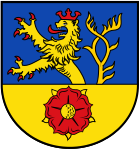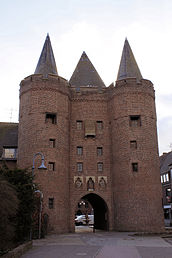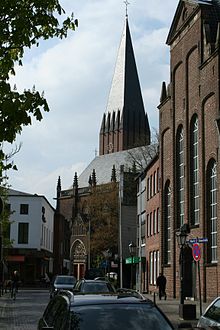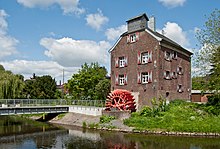Goch
| coat of arms | Germany map | |
|---|---|---|

|
Coordinates: 51 ° 41 ′ N , 6 ° 10 ′ E |
|
| Basic data | ||
| State : | North Rhine-Westphalia | |
| Administrative region : | Dusseldorf | |
| Circle : | Kleve | |
| Height : | 19 m above sea level NHN | |
| Area : | 115.43 km 2 | |
| Residents: | 34,205 (Dec. 31, 2019) | |
| Population density : | 296 inhabitants per km 2 | |
| Postal code : | 47574 | |
| Primaries : | 02823, 02827 | |
| License plate : | KLE, GEL | |
| Community key : | 05 1 54 016 | |
| LOCODE : | DE GOC | |
City administration address : |
Market 2 47574 Goch |
|
| Website : | ||
| Mayor : | Ulrich Knickrehm (Citizens' Forum Goch (BFG)) | |
| Location of the city of Goch in the Kleve district | ||
The city of Goch is a middle district town of the Kleve district in the administrative district of Düsseldorf . It is located on the lower left Lower Rhine in the northwest of the state of North Rhine-Westphalia and is a member of the Euregio Rhine-Waal .
geography
Urban area
The city of Goch has a community area of 115 km² and is approx. 17.1 m above sea level on 6 degrees 09 minutes east longitude and 51 degrees 40 minutes north latitude.
The Niers flows through the city and flows into the Meuse in the Dutch Gennep . Goch is a member of the Niers Association .
Goch has around 35,374 inhabitants (June 30, 2016), who are distributed over the eight districts as follows :
- Goch (20,543 inhabitants)
- Asperden (2,340 inhabitants)
- Hassum (1,142 inhabitants)
- Hommersum (502 inhabitants)
- Hülm (715 inhabitants)
- Kessel (2.134 inhabitants)
- Nierswalde (1,039 inhabitants)
- Pfalzdorf (6,959 inhabitants).
Neighboring communities
The city of Goch borders in the north on the city of Kleve and the communities Kranenburg and Bedburg-Hau , in the east on the community Uedem , in the south on the community Weeze and in the west on the communities Bergen and Gennep (both province Limburg , NL ).
history
The earliest written evidence is from the second half of the 11th century. and is "Gohhe". The name is usually assigned to Middle Low German oog ('Aue') with a collective prefix ge . The starting word should have been * goog (e) ('meadow landscape').
The oldest document in which Goch is referred to as a city is dated 1261. The exact year in which the city rights were granted can no longer be determined; the award probably falls during the reign of Otto II (Geldern) (1229–1271). The first city fortification ring was completed in 1350.
Goch initially belonged to the domain of the counts, and later the dukes, of Geldern . It fell to the Duchy of Kleve in 1473 and to Brandenburg / Prussia in 1614 with the Treaty of Xanten . In the following 200 years the rulership of Goch changed several times: in 1615 the city was conquered by the Dutch. The Spaniards ruled Goch from 1622 to 1625. From 1757 to 1763 there was an occupation by French troops. From 1795 to 1815 Goch belonged to France (see French period ). In 1815 Goch came to Prussia .
In 1741 people from the Palatinate who actually wanted to emigrate to America settled in the Gocher Heide. The village of Pfalzdorf developed from this settlement and became an independent municipality in 1799. This is how a Palatinate language island was created .
In 1847 the Gocher flax market was organized for the first time. Flax markets were very common on the Lower Rhine in the early 19th century . Flax is a crop that was cultivated at the time for fiber production. The Gocher flax market still takes place twice a year; mainly haberdashery are sold on it . The construction of the railway lines Cologne - Kleve ( Lower Left Rhine Railway ) and Boxtel - Wesel ( Boxteler Bahn ), was at the intersection of Goch, favored some new industrial developments and an economic boom in Goch. The Dutch Margarine -Werke Jurgens & Prinzen GmbH was an important industrial settlement . In 1928 it employed over 3000 people in Goch.
In 1905 the municipal cemetery was laid out as a Protestant cemetery, then a Catholic cemetery in 1912.
With the seizure of power , the National Socialist dictatorship began in Goch . Political opponents were immediately persecuted. Members of or supporters of socialist and communist parties were arrested, in some cases physically abused, released from their professions and subjected to the arbitrariness of the SS in the concentration camps . People of the Jewish faith were particularly badly affected. “Between 1933 and 1945 about 90 Germans of the Jewish faith lived in Goch, who are to be remembered in this way. After 1933 they were disenfranchised and ostracized, their businesses were boycotted and destroyed, and they were threatened and driven out. Over half of Goch's Jewish population was killed in concentration camps. Many of them were children. " During the Reichspogromnacht from November 9th to 10th, 1938, the synagogue in Goch on Herzogenstrasse was destroyed and burned down by the SA and SS.
On the night of February 7th to 8th, 1945 and a few days later, on February 12th, 1945, Goch was bombed by Western Allied aircraft. In the course of the battle in the Reichswald , which took place from February 7 to 22, 1945 in the Klever area, there were sometimes heavy fights with house-to-house fighting and artillery use in Goch from February 17 to 22. The destruction caused by the bombing raids and the battle for the city are estimated at around 80% of the development. The leadership of the Allied forces had assumed that bunker systems around Goch represented an extension of the Siegfried Line ( money supply ), which is considered to be one of the reasons for the massive bombing. The aim of the British ground offensive that followed the bombing was to cross the Rhine near Wesel and advance into the Ruhr area.
On the night of May 24, 1993, the 67-meter-high steeple of the St. Maria Magdalena Church collapsed. It took ten years to rebuild. It is widely believed that the collapse was a result of structural damage caused by the bombing in 1945.
On May 18, 2005, Goch was declared a place of pilgrimage by the Bishop of Münster, Reinhard Lettmann . Since the canonization of Father Arnold Janssen, numerous pilgrims have been visiting his baptistery St. Maria Magdalena, his birthplace and the Arnold Janssen parish, which was newly founded in the 1970s.
In the course of 2008 the ring and the train station were expanded.
On September 8, 2011, Goch was the epicenter of an earthquake measuring 4.4 on the Richter scale , which was perceived within a radius of around 200 km.
Territorial reform
Goch was created in its current form on July 1, 1969 during the first municipal reorganization program in North Rhine-Westphalia . The town of Goch, the town of Pfalzdorf and the towns of Asperden , Hassum , Hommersum , Hülm , Kessel and Nierswalde of the Asperden office were merged to form the new town of Goch.
On January 1, 1975, in the course of the second reorganization program in North Rhine-Westphalia, the old Kleve district was merged with the former Geldern district and parts of the Moers and Rees districts to form the new Kleve district in the Lower Rhine .
Population development
The population grew from around 4,000 in 1850 to around 13,600 in 1933. The following information relates to the present-day area of the city of Goch.
- 1975: 28,209 inhabitants
- 1980: 28,779 inhabitants
- 1985: 28,415 inhabitants
- 1990: 29,843 inhabitants
- 1995: 31,186 inhabitants
- 2000: 32,675 inhabitants
- 2005: 33,948 inhabitants
- 2010: 34,106 inhabitants
- 2015: 33,889 inhabitants
- 2016: 33,701 inhabitants
- 2017: 33,618 inhabitants
politics
City council
In addition to the nationally represented parties , two local electoral associations are active in Goch municipal politics: The future in Goch , which emerged from the citizens' initiative against the new town hall in Goch, and the BürgerForum Goch , which was founded in 2007 by former SPD councilors.
Since the last local election on May 25, 2014, the CDU (40.0%, 18 seats), SPD (20.6%, 9 seats), BürgerForum Goch (BFG) (23.7%, 10 seats) and FDP have been in the city council (5.3%, 2 seats), Greens (6.8%, 3 seats) and Zukunft in Goch (ZIG) (3.7%, 2 seats).
The next local election will take place in 2020.
mayor
Ulrich Knickrehm ( BürgerForum Goch ) was elected mayor on September 27, 2015 .
Coat of arms, seal, banner and logo
The city of Goch was last given a coat of arms, a seal and a flag (banner) on December 10, 1970. The city also has a logo.
coat of arms
Blazon : "Humiliated divided by blue and gold, above a growing, red-crowned and red-armored, two-tailed golden lion, below a five-petalled red Geldern rose (medlar flower) with golden lugs and golden sepals."
Description of the coat of arms: The two-tailed golden lion is the Geldern lion , the five-petalled red medlar flower is the Geldern rose , both of which indicate that the city of Goch was part of the former Duchy of Geldern. The coat of arms comes from the older city seal, which contains the city coat of arms as a seal image in a pointed triangular pass with blunt tips in the joints (decoration of three outwardly rounded arches around the inner seal image) in the following tinging : "Degraded divided by black and silver , above a growing, two-tailed silver lion, below a five-petalled silver medlar flower (Geldern rose). "
seal
The inscription of the seal reads: "Stadt Goch". Seal image contains on a provided in the joints with three blunt tips pass the city arms in the following tincture : "In black and white lowered shared shields above-growing, zwiegeschwänzter white lion, below a five-leaved white Mispelblüte."
banner
The flag (banner) is striped lengthways in a ratio of 1: 1 and bears the colors blue-yellow. The white head of the banner shows the coat of arms.
Town twinning
-
 Veghel ( Netherlands )
Veghel ( Netherlands ) -
 Redon ( France )
Redon ( France ) -
 Nowy Tomyśl ( Poland )
Nowy Tomyśl ( Poland ) -
 Andover ( England )
Andover ( England ) -
 Putignano ( Italy )
Putignano ( Italy )
Debt
The city of Goch has the highest debts in the Kleve district .
Culture and sights

|

|
|
|
North / field side of the stone gate
|
Museums
Culture
- Culture and Congress Center Kastell
- Kultourbühne Goch
- Stringtime Niederrhein
- Children's musical workshop "Ritter Rost"
- Klostergut Graefenthal (Former Cistercian Abbey)
- Goch City Library
- City Archives
Attractions
- Church of Our Lady
- Arnold Janssen Church
- House of the Five Rings (16th century)
- Parish church Maria-Magdalena (14th-16th century, church tower collapsed May 24, 1993, modernized rebuilt in 2003)
- Stone gate (14th century)
- Susmühle (18th century)
- House of the St. Johannes monastery (formerly the public library )
- Graefenthal Monastery Estate
- Poor men's house (16th century)
- Poor women's shelter (16th century)
- Langenberghaus
- Birthplace of St. Arnold Janssen
- Viller mill
- Collegium Augustinianum Gaesdonck with the late Gothic collegiate church
- Evangelical church on the market in Goch
- Town hall: “Gocher series” by the Düsseldorf artist Horst Wackerbarth
Recreational facilities
- The Viller Mühle houses the world of the "insane puppeteer " Heinz Bömler. Numerous cultural events take place here. You can also visit the collections of old shops, historical toys and curiosities by prior arrangement.
- A handful of restaurants invite you to the asparagus village of Kessel for the asparagus season .
Sports
- In the leisure pool "GochNess" (Kessel) there is a natural swimming lake with a sandy beach and inside a competition and adventure pool, as well as a large sauna area.
- Other sports activities: 43 sports clubs, 17 sports fields (including four school sports facilities), sports hall at the Städt. Gymnasium in Goch, four gymnastics halls, three tennis halls, three tennis facilities, two riding arenas with riding arenas, three riding areas, an aviation area, two fitness trails, fun and action park with inline skate park, miniature golf course, shooting range, paddle boat and Bike rental.
Economy and Infrastructure
Industry
The sporting goods company Derbystar is based in the village . Goch Vehicles The Turkish company Tirsan produced the trailer make Kässbohrer . In 1959, the company Nutr-Engel GmbH (now Engel Food Solutions) expanded its range to include dry potato products through a plant in Goch. Since the end of 2012, Siemens Mobility has been producing prefabricated side walls, roofs and parts for the underframes of all of the Group's local transport vehicles for its rail vehicle plant in Krefeld - Uerdingen in the former Tirsan hall . Gocher Fahrzeugbau GmbH (Gofa), founded in 1962 and now part of the American company Chart Industries, is also active in vehicle construction .
traffic
Public transport
The regional tariff of the Verkehrsverbund Rhein-Ruhr (VRR) and the NRW tariff apply to all local public transport (ÖPNV) .
rail
The Goch train station is on the left Lower Rhine route , on which the RE 10 "Niers-Express" runs from Kleve via Krefeld to Düsseldorf every hour and every half hour from Monday to Friday . Local rail passenger transport is carried out by the NordWestBahn (NWB), which uses LINT 41 diesel multiple units in single to triple traction. The current station building was built in 1957 according to the designs of the architect Toni Hermanns . It consists of a spacious reception hall with a high window front on the city side, framed by single-storey extensions with service rooms, a train station restaurant and the associated tenant apartment. As a typical post-war modern building , the 1966 train station was the model for Faller's "Neustadt Train Station" model railroad kit . The classic model was relaunched in 2016.
buses
There are a number of bus routes in public transport that open up the region and the city. The operator of the bus lines is the Stadtwerke Goch .
Streets
In the trunk road area , Goch is connected to the federal highway 57 ( E 31 ) via the federal highway 9 .
Air traffic
The closest airports are Niederrhein Airport and Düsseldorf Airport .
German Red Cross
The DRK local association Goch e. V. within the German Red Cross was originally founded in 1899 by the Gocher doctor Eugen Förster as a volunteer medical team. Today the members do voluntary work within the DRK readiness. a. in blood donation campaigns , medical services , disaster control and all events in Goch and the surrounding area. Children and young people from the age of 6 are offered the opportunity to work in the Youth Red Cross as well as to take part in the annual holiday camp in the Sauerland .
Telephone prefixes
In the city the area code is 02823. The 02827 is valid in the districts of Kessel , Hassum and Hommersum .
Personalities
- Otto III. (980–1002), Roman-German king and emperor
- Dietrich Vaelbier (called von Goch) (before 1300–1366), margravial personal physician , professor of medicine, dean of the Meißner cathedral chapter
- Johann Pupper (1410–1475), theologian and pre-reformer
- Aleidis Raiscop (1449–1507), humanist writer
- Martin Schenk von Nideggen (1540–1589), Count of Afferden and Blijenbeek, war bishop
- Heinrich Turck (1607–1669), Jesuit historian
- Martin Wilhelm Fonck (1752–1830), Vicar General of the Diocese of Aachen
- Friedrich Wilhelm Curtius (1782–1862), entrepreneur in the chemical industry
- Father Arnold Janssen (1837–1909), founder of the globally active Steyler Missionswerk and student of the Collegium Augustinianum Gaesdonck
- Julius Heveling (1842–1909), Roman Catholic pastor of Pfalzdorf and member of the Prussian House of Representatives
- Ferdinand Langenberg (1849–1931), art carver and sculptor
- Carl Mosterts (1874–1926), Nestor of the Catholic youth pastoral care and youth association work in Germany
- Johannes van Acken (1879–1937), Catholic clergyman and Caritas functionary
- Josef Edmund Janßen (1881–1966), Roman Catholic pastor and prelate, honorary citizen of the city of Wesel
- Heinrich Hamm (1889–1968), sculptor
- Aenne Biermann (1898–1933), photographer
- Curt Peters (1905–1943), theologian and orientalist
- Hubert Houben (1898–1956), track and field athlete
- Gerd Horseling (1903–1992), member of the Reichstag for the KPD
- Irmfried Benesch (1912–1987), writer (pseudonym Fridolin Aichner)
- Rudolf Schlidt (1914–2012), space pioneer
- Heinz Kotthaus (1917–1972), CDU politician
- Rudolf Schoofs (1932–2009), artist
- Friedrich Tomberg (* 1932), German philosopher and agent for the Ministry for State Security
- Arnold Angenendt (* 1934), theologian and church historian
- KA Janßen (* 1937), artist
- Manfred Streit (1939–2017), economist
- Jiři Keuthen (1951–2007), artist
- Heinz Eickmans (* 1953), Dutch and Germanist
- Edgar Geenen (1954–2007), football official
- Josefa Idem (* 1964), former canoeist and Italian minister
- Jens Loors (* 1967), police officer and leading actor in the crime series K11
- Carola Reimann (* 1967) SPD politician, Lower Saxony Minister for Social Affairs, Health and Equality
- Rita Kersting (* 1969), art historian and curator
- Jens Ernesti (* 1977), singer
- Dennis Brammen (* 1988), German YouTuber from the PietSmiet channel
- Luisa Wensing (* 1993), soccer player at SV Werder Bremen
literature
- Guido Blietz: Goch from 1900 to 1939 . Sutton Verlag, Erfurt 2006, ISBN 3-86680-017-7 .
- Marie-Theres Deußen: On the history of the expellees in Goch (= Goch series of publications, No. 5), 1995, ISBN 3-926245-30-1 .
- Elke Dißelbeck-Tewes: Women in the Church. The life of women in the Cistercian convents of Fürstenberg, Graefentahl and Schledenhorst . Verlag Böhlau, Cologne 1989, ISBN 3-412-17089-5 .
- Hans-Joachim Koepp: Celts, church and mashed potatoes. Chronology of the 750-year history of the city of Goch
- From prehistory to the Brandenburg period (1614) . 2004, ISBN 3-926245-67-0 .
- From the Thirty Years War to the German Revolution (1615–1846) . 2006, ISBN 3-926245-73-5 .
- From the German Revolution to the Belgian occupation (1847–1919) . 2008, ISBN 978-3-926245-80-9 .
- Reinhard Schippkus: Aspects of the history of Goch 1933-1945 (= series of publications of the city of Goch, No. 4), 1994, ISBN 3-926245-17-4 .
Web links
- Website of the city of Goch
- Project of the Mittelkreis Comprehensive School Against Forgetting - Nazi Victims from Goch and Uedem
Individual evidence
- ↑ Population of the municipalities of North Rhine-Westphalia on December 31, 2019 - update of the population based on the census of May 9, 2011. State Office for Information and Technology North Rhine-Westphalia (IT.NRW), accessed on June 17, 2020 . ( Help on this )
- ^ Manfred Niemeyer (ed.): German book of place names . De Gruyter, Berlin 2012, ISBN 978-3-11-018908-7 , pp. 212 .
- ↑ Since the decision of the Goch City Council on June 14, 1973, funerals are no longer carried out according to religious affiliation.
- ↑ This text comes from the description of the project Against Forgetting of the Comprehensive School Mittelkreis [1]
- ↑ Our glass cabinet shook. In: Kölner Stadt-Anzeiger . September 8, 2011, accessed April 26, 2020 . .
- ↑ Martin Bünermann: The communities of the first reorganization program in North Rhine-Westphalia . Deutscher Gemeindeverlag, Cologne 1970, p. 79 .
- ↑ Population of all municipalities in North Rhine-Westphalia from December 31, 1962 at the end of each year according to the current territorial status .
- ↑ a b Election results for the 2014 municipal elections ( memento of the original from September 3, 2014 in the Internet Archive ) Info: The archive link was inserted automatically and has not yet been checked. Please check the original and archive link according to the instructions and then remove this notice. Municipal data center Niederrhein.
- ↑ [2] Main statute of the city of Goch § 2, paragraph 3.
- ↑ RP ONLINE: Kleve district: Goch has by far the most debts in the district. Retrieved March 11, 2020 .
- ↑ Michael Baers: Goch: Siemens builds wagons in Tirsan-Halle. rp-online.de, January 5, 2013, accessed on November 28, 2015 .
- ↑ Katrin Reinders: Goch: GOFA has a new "boss" , rp-online.de, June 9, 2012, accessed on August 5, 2012.
- ↑ Bartetzko, Daniel, Berkemann, Karin, Deutsches Architekturmuseum, Jovis Verlag GmbH: märklinMODERNE: from building to kit and back = from architecture to assembly kit and back again . Berlin 2018, ISBN 978-3-86859-518-5 .










